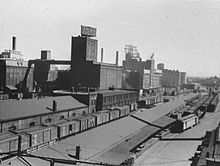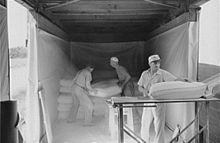Northwestern Consolidated Milling Company was an American flour milling company that operated about one-quarter of the mills in Minneapolis, Minnesota, when the city was the flour milling capital of the world.[1] Formed as a business entity, Northwestern produced flour for the half-century between 1891 and 1953, when its A Mill was converted to storage and light manufacturing.[2] At its founding, Northwestern was the city's and the world's second-largest flour milling company after Pillsbury, with what is today General Mills a close third. The company became one of three constituents of a Minneapolis oligopoly that owned almost nine percent of the country's flour and grist production and products by 1905. This occurred as a result of their attempt at a United States monopoly.[2][3]


History
edit| Consolidation of Minneapolis Flour Mills[4] | ||
|---|---|---|
| Year | Companies | Market Share |
| 1882 | 2 | 51% |
| 16 | about 49% | |
| 1890 | 4 | 87% |
| 1900 | 3 | 97% |
| 1891 Capacity in Barrels[5] | ||
|---|---|---|
| Company | Mills | Daily |
| Pillsbury-Washburn | 5 | 14,500 |
| Northwestern Consol. | 6 | 10,500 |
| Washburn-Crosby | 3 | 9,500 |
| Minneapolis Flour Mfg. Co. | 4 | 3,500 |
Technological advances in flour milling were already in place by the 1880s, when 18 different millers operated in Minneapolis. From that point on and for the next 50 years, mergers and changes in business administration were the primary developments in the industry.[2]
Northwestern and their new Ceresota[6] flour brand name were established in July 1891 by a group of businessmen led by former lumberman John Martin at six independent existing mills—the Crown Roller (2,500 barrels/day), Columbia (2,000), Northwestern (1,600), Pettit (1,600, to be an elevator), Galaxy (1,500) and Zenith (1,100). Martin became president, Joel B. Bassett was vice president, C. T. Fox was secretary and treasurer, and Fred C. Pillsbury, E. Zeidler and Albert C. Loring were the managers. The company grew to nine mills and several elevator and storage facilities.[2] Loring's father Charles M. Loring was one of the directors.[5]
Northwestern's first decade was marked by financial instability because its founders paid too much for its properties and suffered from lack of capital. A reorganization followed in 1895 that somewhat alleviated the company's problems. In 1898–1899 the United States Milling Company formed at the Hecker-Jones-Jewell mills in New York City with the goal of becoming a flour monopoly by owning nearly all of the country's spring wheat mills. Northwestern, though, was the only company they acquired. Financially troubled, U.S. Milling in 1900 reorganized and became the Standard Milling Company with Northwestern as a subsidiary.[2]
By combining six mills, Northwestern's capacity was the second largest in the world at the time of its founding, after the giant Pillsbury-Washburn, and slightly more than Washburn, Crosby. By 1900, these three companies were an oligopoly holding 97 percent of the Minneapolis market.[2] In 1928 Washburn, Crosby became General Mills in a merger of U.S. millers and surpassed Pillsbury to become the world's largest flour milling company. In recent years General Mills acquired Pillsbury.[7]
In January 1909, Northwestern opened its state of the art Elevator A, possibly the largest grain elevator ever built of brick. The elevator could hold 1,000,000 bushels of grain and its conveyors could each move 10,000 bushels per hour to the Crown Roller and Standard mills.[2] Along with Elevator B known as the Pettit Mill of which only the foundation remains, Almost all the properties in this article are contributing resources to the St. Anthony Falls Historic District which is on the National Register of Historic Places.[8]
Ceresota brand
editThe company named Ceresota Flour for an invented son of the Greek goddess Ceres, Ceres Ota. The advertising story described a young boy exploring earth in a costume of gifts from different countries. An Egyptian king provided his trousers; from Italy, he got his blue blanket; the Amazon contributed his bench, boots, suspenders, and shirt; Japan gave him a gold shield; and a miller gifted him with the brown sombrero. Each Ceresota Flour sack displayed a picture of Ceres Ota slicing a giant loaf of bread.[9]
Ceresota is now a brand name of The Uhlmann Company[10] and American Home Foods.[6]
Today
editAfter the center of U.S. flour milling moved to the east coast, the company's A and F Mills closed during the 1940s and 1950s. Of the 34 Minneapolis flour mills, only four are still standing on the Mississippi's west bank.[11] Of the four, the Crown Roller Mill and the Standard Mill were Northwestern mills (the A and F mills). Of concern to preservationists, Omni Investment had plans to build a condominium development on top of the remains of the Northwestern B mill and adjacent archaeological sites but the plan is stopped and is now in the court system.[12][13][14] The plan was defeated and the Park Board redeveloped the site into Water Works Pavilion and Restaurant (2021).[15] Elevator A was converted to an office building in 1987, and converted again about 2015 to Millers Landing Senior Living. [16] Crown Roller Mill is in use today as an office building. The Standard Mill became the Whitney Hotel (1987) but closed. It is now the Whitney Lofts (2007).
Mills
edit| Northwestern Consolidated Mills[17] | ||||||
|---|---|---|---|---|---|---|
| Mill | Owners | Architect/Construction | Extant | Northwestern | Remains | Image |
| Crown Roller Mill | Charles Morgan Hardenbergh, John A. Christian, Llewellyn Christian, Charles Everett French | William F. Gunn | 1879- | A Mill | office building | |
| Columbia Mill | Columbia Mill Company | 1882-1941 | B Mill aka Ceresota Mill | under Water Works Pavilion, visible from Mississippi | ||
| Galaxy Mill | W. P. Ankeny, W. F. Cahill, Loren Fletcher, Charles M. Loring, Albert C. Loring[18] | 1874-1931 | C Mill | foundation visible, Mill Ruins Park | ||
| Northwestern Mill | Siddle, Loren Fletcher and Holmes, John Martin[19] | 1879-1931 | D Mill | foundation visible, Mill Ruins Park | image | |
| Zenith Mill | Leonard Day and M. B. Rollins | 1871-1931 | E Mill | foundation visible, Mill Ruins Park | image | |
| Standard Mill | Ebenezer White and Dorilus Morrison, Whitney Hotel | Otis Arkwright Pray and William Dixon Gray | 1879- | F Mill | Whitney Lofts (2007) | |
| Arctic/St. Anthony Mill | Perkins, Crocker, and Co., Hineline, Plenk and Wheeler | 1866-1919 | H Mill | foundation visible | ||
| Elevator A / Ceresota | Northwestern | George T. Honstain, Fred W. Cooley | 1908- | Elevator A | Millers Landing Senior Living | |
| Pettit Mill | Pettit, Robinson, and Company | 1875-1931 | Elevator B | visible, Mill Ruins Park | image | |
| New City Waterworks | City of Minneapolis | 1883-ca.1931 | storage | foundation remains | ||
| Union Mill | Henry Gibson | 1863-ca. 1919/29 | storage | foundation visible | ||
| Minneapolis Boiler Works | M. W. Glenn, unknown | ca. 1878 - 1985 | storage | foundation probably destroyed | ||
| Phoenix Iron Works | D. Douglas and J. M. Schultz, Wilford and Northway | ca.1881-1985 | storage | foundation probably destroyed | ||
See also
edit- Ceresota Building
- History of Minneapolis
- St. Anthony Falls Historic District
- Whitney Mill Quarter Redevelopment a 1980s redevelopment of the Crown Roller Mill, Standard Mill, Ceresota Elevator and Minneapolis Boiler Works
References
edit- ^ Mill City Museum. "History". Archived from the original on February 18, 2007. Retrieved April 4, 2007.
- ^ a b c d e f g h Frame, Robert M. III; Hess, Jeffrey A. (January 1990). "Northwestern Consolidated Elevator 'A'" (PDF). Historic American Engineering Record. Washington, D.C.: Library of Congress. Archived (PDF) from the original on July 30, 2021. Retrieved September 17, 2021.
- ^ Salisbury, Rollin D.; Barrows, Harlan Harland; Tower, Walter Sheldon (1912). The Elements of Geography. University of Michigan, reprinted by H. Holt and Company. pp. 441.
- ^ a b Atwater, Isaac (1893). History of the City of Minneapolis, Minnesota. pp. 408, 630–631 – via Google Books.
- ^ a b American Home Foods/The Uhlmann Company (n.d.). "About Us". Archived from the original on July 17, 2007. Retrieved April 14, 2007.
- ^ "General Mills history of innovation" (PDF). Archived from the original (PDF) on December 11, 2006. Retrieved April 21, 2007.
- ^ Coddington, Donn. "Nomination of the St. Anthony Falls Historic District to be on the National Register of Historic Places". (1971, 1991). US-DOI-NPS. Archived from the original on February 10, 2022. Retrieved February 1, 2022. Has extensive information on the significance of the district and descriptions of "contributing resources". All the properties in this article are "contributing resources" except for the Phoenix Iron Works which was one of the companies in the Minneapolis Boiler Works building and the Minneapolis Boiler Works.
- ^ Andes, Karrie K.; Norman, Sandra J. (1998). Vintage Cookbooks and Advertising Leaflets. Schiffer Publishing. p. 26. ISBN 0764306219.
- ^ "The Uhlmann Milling Company | Heckers and Ceresota Flour". Archived from the original on October 26, 2021. Retrieved March 17, 2022.
- ^ Hess, Demian; Hess, Jeffrey A. (January 1990). "Crown Roller Mill" (PDF). Historic American Engineering Record. Washington, D.C.: Library of Congress. p. 17. Archived (PDF) from the original on September 18, 2021. Retrieved September 17, 2021.
- ^ Bruch, Michelle (September 18, 2006). "Riding the Wave". Downtown Journal. Archived from the original on January 23, 2021. Retrieved April 20, 2007.
- ^ "Debate over the Wave condo project rolls on". February 2, 2007. Archived from the original on August 7, 2020. Retrieved April 20, 2007.
- ^ "Development roundup: Wave developers file lawsuit against Park Board". March 29, 2007. Retrieved April 19, 2007.
- ^ "Water Works Pavilion - history". Minneapolis Park and Recreation Board. Retrieved January 1, 2022. In a commercial rediscovery of the abandoned west bank riverfront, the Fuji Ya restaurant opened in 1968, built on the partially exposed foundations of the Bassett Sawmill enginehouse and the Columbia Flour Mill. The restaurant closed by 1990 and the building, bought by the Minneapolis Park board, sat abandoned. The building was demolished and a new Water Works Pavilion and Restaurant, built by the Park Board on the same historic foundations, opened in 2021.
- ^ DePass, Dee (July 8, 2020). "Owner of Ceresota senior-living facility in downtown Minneapolis files for bankruptcy". Minneapolis StarTribune. Archived from the original on February 16, 2022. Retrieved February 1, 2022.
- ^ Anfinson, Scott F. (1989). "Archaeology of the Central Minneapolis Riverfront, Part 1". The Minnesota Archaeologist. 48 (1–2). Archived from the original on October 9, 2007. Retrieved April 18, 2007.
- ^ Shutter, Marion Daniel (1923). History of Minneapolis, Gateway to the Northwest. The S. J. Clarke Publishing Co. Retrieved April 16, 2007 – via Rootsweb.com.[permanent dead link]
- ^ Atwater, Isaac (1893). History of the City of Minneapolis, Minnesota. Archived from the original on February 25, 2023. Retrieved April 21, 2007 – via Google Books.
Further reading
edit- Minneapolis Public Library (2001). "A History of Minneapolis: Milling". Archived from the original on April 27, 2007. Retrieved April 20, 2007.
- Anfinson, Scott F. (1989). Archaeology of the Central Minneapolis Riverfront, Part 1 and Part 2. Retrieved on April 14, 2007.
External links
edit- Historic American Engineering Record (HAER) documentation, filed under Minneapolis, Hennepin County, MN:
- HAER No. MN-12, "Crown Roller Mill, 105 Fifth Avenue South", 29 photos, 28 data pages, 3 photo caption pages
- HAER No. MN-13, "Minneapolis Boiler Works Building, 121-129 Fifth Avenue South", 8 photos, 16 data pages, 1 photo caption page
- HAER No. MN-14, "Standard Mill, 116-118 Portland Avenue South", 51 photos, 26 data pages, 4 photo caption pages
- HAER No. MN-16, "Northwestern Consolidated Elevator 'A', 119 Fifth Avenue South", 95 photos, 19 data pages, 6 photo caption pages